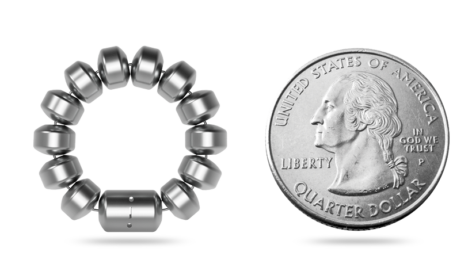LINX System
What is the LINX System for GERD?

The LINX® System is a minimally invasive and effective treatment for GERD. It is a small, flexible band of magnets (about the size of a quarter) enclosed in titanium beads designed to help the sphincter located at the opening of the stomach stay closed to stop the reflux. When surgically placed around the outside of the esophagus, the magnetic attraction between the beads helps the sphincter remain closed to prevent reflux. Because LINX is constructed of titanium and permanent magnets, it is designed to last your lifetime.
Benefits of LINX Compared to Other Acid Reflux Surgeries
LINX patients report improved quality of life and relief from heartburn and other GERD symptoms. Many patients no longer rely on acid reflux medication following surgery.
In addition to relief from chronic acid reflux, there are benefits to the procedure itself. These include:
- Minimally invasive
- Short outpatient procedure
- No alteration to the stomach
- Improved quality of life
- Freedom from medication
- No long term gas bloat
The LINX Procedure
The LINX System is implanted to encompass the esophageal sphincter, just above the stomach. The magnetic attraction between the beads helps keep the weak lower esophageal sphincter (LES) closed to prevent reflux (see image below). Swallowing temporarily breaks the magnetic bond, allowing food and liquid to pass into the stomach (see second image below). Magnetic attraction closes the LES after swallowing to reinforce the body's natural barrier to reflux.
The LINX device is implanted using a standard minimally-invasive laparoscopic procedure. Patients are placed under general anesthesia during the procedure, which usually takes less than one hour. Unlike other surgeries used to treat GERD, LINX is implanted around the outside of the Lower Esophageal Sphincter (LES). This means there is no alteration to the stomach. In most cases, patients go home the day after surgery and shortly thereafter resume a normal diet.
What LINX Patients Can Expect After Surgery
Because every patient is unique, you can expect Dr. Howard to give you specific instructions about post-procedure care based on your situation. In most cases, patients can resume work and most normal activities within several days. It is important that you not lift heavy items or do any strenuous physical exercise until after your post-follow-up exam. Some difficulty swallowing (dysphagia), increased belching (burps), or chest pain is common for a short period of time after the procedure.
Every individual is different, but for most, soft foods can be tolerated shortly after surgery. Some foods might be hard to swallow. Drinking warm liquids, such as tea, can help by relaxing the esophagus. However, if that doesn't make swallowing easier, hold off on that food and try again a week later.
Most patients who are interested in a Linx will need some additional tests before the procedure can be performed. This may include:
- Barium swallow. Involves drinking a chalky liquid that coats and fills the inside lining of your digestive tract. The coating shows up on an X-ray, allowing your doctor to see a silhouette of your esophagus, stomach, and upper intestine.
- Endoscopy. A thin, flexible tube equipped with a light and camera (endoscope) is placed down your throat to examine the inside of your esophagus and stomach and check for inflammation.
- Esophageal manometry. A different kind of tube goes down your throat to check the rhythmic muscle contractions in your esophagus when you swallow.
- Marshmallow-Bagel swallow test. Involves lying down and drinking some barium after eating a marshmallow and a bagel while radiology takes some x-rays.
For an in-depth discussion regarding the LINX System schedule an appointment with Dr. Howard at our office in The Woodlands, Texas.
Learn more about surgical procedures available to treat chronic acid reflux.